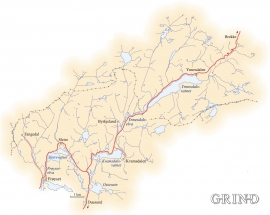Published: 28.10.2004 | Author: Stein Byrkjeland
Portion of the Frøysetelva River, by Sleire. (Svein Nord)
A RIVER NETWORK-LABORATORY
Frøyset river network is protected from power station-building - not because of its pristine nature - but because it is a typical river network for this part of western Norway.
Frøyset river network was protected in 1986. The protection was undertaken as a result of extensive scientific studies carried out around 1980. 272 species of vascular plant were documented in the area. This number is not especially high, considering that 60 percent of the water system lies under the tree limit. 20 species of small crustaceans, 14 species of water fleas and 6 species of copepods were also documented. Neither is this an especially high diversity. The waterway as such is a rather simple ecosystem, with the most common animal groups, but few species in each group. The simplicity of the ecosystem makes it possible to study the biological processes in the water system. Likewise, it is also correspondingly easier to compare with conditions in other river networks.
Not least, Frøystelva River is an important "laboratory" for studying the effects of acid rain. Also in this respect, the river represents an uncomplicated system. Its collective drainage basin is on the order of 120 km². The water runs through an area with homogeneous, hard bedrock, mostly gneiss, but also some quartzite. This type of bedrock gives off only a very small quantity of ions to the water. Both the river and the lakes are therefore quite acidic. The pH-values were measured to between 4.6 - 4.9 early in the 1980s. The river network therefore has a low capacity to buffer against outer influences, such as acid rain.
Limiting the water system
From the outflow from Lake Ostavatn, slaked lime has been added to the Frøyset River since 1991. By the outflow there is a big lime-spreading machine, one of three of its kind in Hordaland. In addition, slaked lime is added to many streams and ponds in the county through other means.
Lime is used to neutralize the acidity of the waterways. Without this first aid treatment, the fish populations could die out because of the high levels of acid and aluminium in the water. The main problem is the acid rain, which is the result of industrial discharge further south in Europe. The work to stop or at least decrease this discharge has taken a long time. Even though the acid rain now is significantly reduced, one reckons that liming must continue for a couple of decades into the future - at least - if the most threatened fish populations are to survive. In 2002, 6 million crowns were used in the liming of waterways in Hordaland. On a national basis 100 million crowns were used the same year on such measures.
Liming of Norwegian waterways took off early in the 1990s, and has had much to say about preserving the local fish populations. But, liming is far from a satisfactory method of solving environmental problems, by simply creating another. The slaked lime may keep the fish alive until the situation improves. but it can also have negative consequences for other organisms that live in or near the waterways. In the Frøyset water system, the Grey Heron is nearly absent today from the limed part of the water system, and the amount of loons is also significantly reduced. This need not come from the liming, but one must be careful that well meant initiatives don't cause have side-effects that are harmful to other species not belonging to the targeted group. Besides, it is an expensive form of emergency aid. The critics of liming have grown in number in recent years.
In Masfjorden, the local people do not want to hear about about the high doses of lime that have been used over long periods of time. On an initiative from the municipality, a new lime-spreader was therefore developed, and has since been taken into use throughout the whole country.
- Bjørklund, A. E. 2002. Vassdrag i Hordaland 2000. Rådgivende Biologer og Fylkesmannen i Hordaland, MVA-rapport 3/2002.
- Miljøverndepartementet 1983. Naturfaglige verdier og vassdragsvern. Norges Offentlige Utredninger 1983:42.





